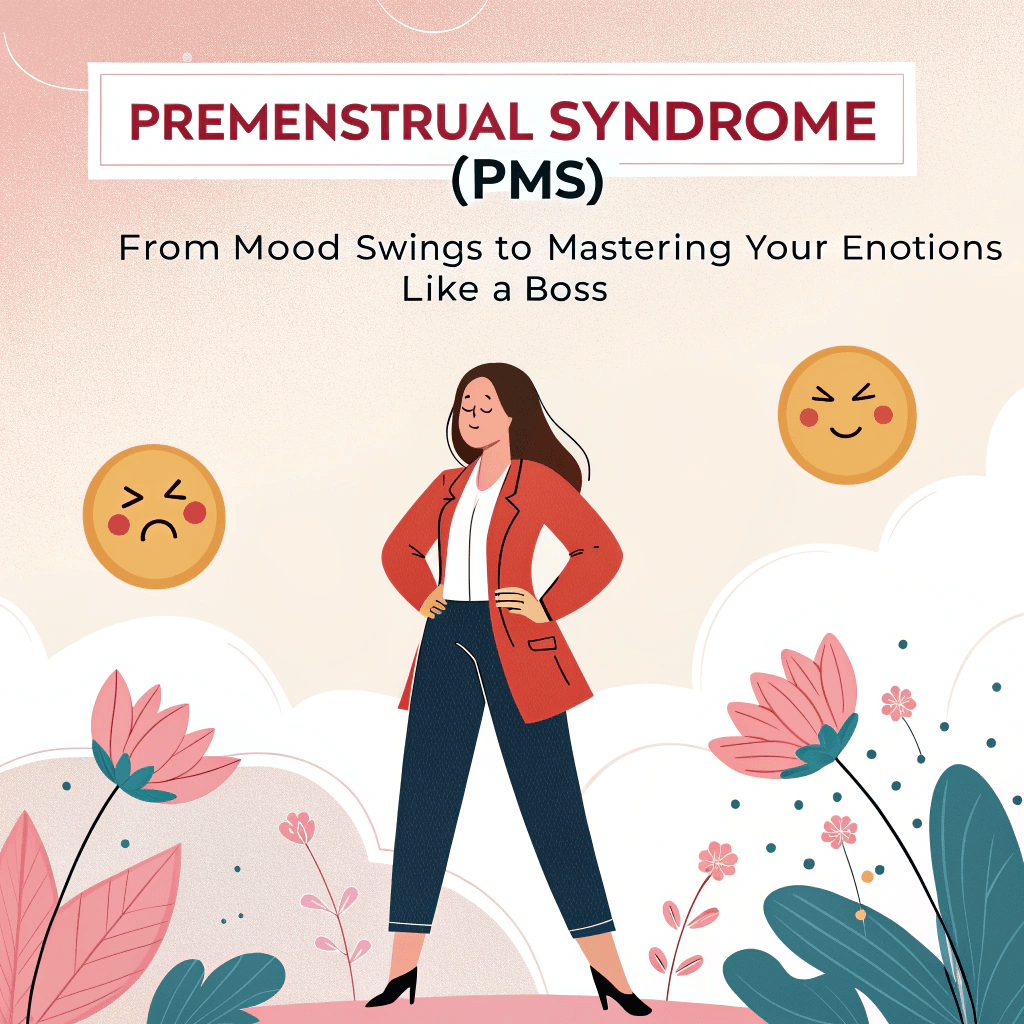Premenstrual Syndrome (PMS): From Mood Swings to Mastering Your Emotions Like a Boss
Table of Contents
Premenstrual Syndrome (PMS) can make you feel like you’re weeping over a cat video, rage-texting your partner, or convinced the world is crashing down—just days before your period. You’re not alone. Welcome to the rollercoaster of PMS. But what if PMS isn’t a problem to be fixed—but a message to be decoded? In this blog, we’ll explore what PMS actually is, why it feels like an emotional tornado, and practical, science-backed, and soul-friendly ways to regulate your emotions during this time. Because, dear reader, you deserve to feel like a Queen—even during PMS.
What Is Premenstrual Syndrome (PMS)?
Premenstrual Syndrome (PMS) is a set of emotional, physical, and behavioral symptoms that occur in the 1–2 weeks before your period begins. It affects more than 75% of menstruating women, according to research from the American College of Obstetricians and Gynecologists.
Common emotional symptoms include:
- Anxiety or nervousness
- Mood swings or irritability
- Crying spells or sadness
- Low self-esteem or self-doubt
- Difficulty concentrating
- Insomnia or fatigue
While hormones like estrogen and progesterone play a key role, PMS is not just hormonal—it’s psychosomatic and energetic. It reveals where you’re suppressing emotions, neglecting self-care, or over-giving.
The Emotional Landscape of Premenstrual Syndrome (PMS)
The truth is, Premenstrual Syndrome (PMS) magnifies what you’ve been ignoring. Think of it as a monthly emotional audit.
That tiny issue you brushed off all month?
That resentment you never voiced?
That self-criticism you didn’t heal?
PMS brings it all to the surface for healing.
Here’s what many women commonly feel during PMS:
- Overwhelmed: Your body is doing an internal cleanse, and your mind is catching up.
- Triggered by small things: Because unprocessed emotions are bubbling up.
- Lonely: Even if you’re surrounded by people.
- Hyper-critical: Especially towards yourself.
But instead of numbing out or simply powering through, what if you could learn to listen to these signals and regulate your emotions in healthier ways?
Regulating Your Emotions During Premenstrual Syndrome (PMS): A 5-Step Soul Strategy
PMS doesn’t have to feel like an emotional tornado. With the right practices, you can transform this phase into a time of deep self-awareness and healing. Here’s a 5-step soul strategy to regulate your emotions during Premenstrual Syndrome (PMS):
1. Name It to Tame It
“I’m not crazy, I’m cycling.”
Track your cycle using apps like Clue or Flo and understand your personal PMS window. The moment you say, “This is PMS,” you reduce the shame and begin reclaiming power.
Pro tip: Journal your emotions daily—you’ll notice patterns and slowly gain mastery over your moods.
2. Use EFT (Emotional Freedom Technique)
EFT, also known as the Emotional Freedom Technique, is a simple yet powerful practice that involves tapping on acupressure points while acknowledging your emotions. This technique can bring instant nervous system relief during Premenstrual Syndrome (PMS).
Try this EFT script:
“Even though I feel irritated and overwhelmed, I deeply love and accept myself. I allow my body to release what no longer serves me.”
👉 Practice EFT daily during your PMS week for 5–7 minutes to calm emotional turbulence and regain balance.
3. Inner Child Check-In
PMS often activates old childhood wounds—like rejection, abandonment, or not feeling good enough. This is a perfect time to nurture your inner child.
Ask yourself:
- “Which part of me is feeling neglected right now?”
- “What would I tell my 10-year-old self who’s scared and anxious?”
Sometimes, a gentle “I’m here for you” can do wonders.
4. Clear the Judgments
PMS is not an excuse to go rogue, but it is a time when your emotional walls thin—making judgments, projections, and expectations more painful.
Try Access Bars:
Access Bars is a body process that helps release stored negative thoughts, feelings, and emotions by lightly touching specific points on the head. It can help you release the heaviness of PMS.
5. Move + Nourish + Rest
Your body is asking for care—listen to it.
- Practice slow yoga or dance freely to your favorite playlist.
- Eat grounding, warm foods (while avoiding caffeine and refined sugar).
- Sleep more—your body is recalibrating.
- Sip herbal teas like chamomile, ginger, or raspberry leaf to soothe cramps and calm the mind.
Bonus: What Premenstrual Syndrome (PMS) Might Be Trying to Tell You (Beyond Hormones)
PMS symptoms aren’t just random—they can be emotional messages from your body and subconscious. Instead of only blaming hormones, try decoding what your Premenstrual Syndrome (PMS) symptoms are really pointing towards:
Symptom
Anger & Irritability |
Anxiety |
Sadness |
Loneliness |
Brain Fog |
Possible Emotional Message
Where are you saying yes when you really mean no? |
Are you over-committing or trying to control outcomes too tightly? |
What emotions have you been suppressing all month? |
Are you giving too much and receiving too little in return? |
Are you disconnected from your body and inner intuition? |
When to Seek Help for Premenstrual Syndrome (PMS)
While Premenstrual Syndrome (PMS) is common, it shouldn’t take over your life. If PMS symptoms are seriously affecting your relationships, work, or overall quality of life, you might actually be experiencing PMDD (Premenstrual Dysphoric Disorder)—a more intense form of PMS.
In such cases, it’s important to seek professional support:
- Consult a gynecologist for medical evaluation.
- Reach out to a mental health professional if emotional symptoms feel overwhelming.
- Consider working with an emotional resilience coach trained in somatic healing or regression therapy for holistic support.
Remember: You don’t have to suffer in silence. Help is available—and healing is possible.
Final Thoughts: Your Period Is Not a Problem—It’s a Portal
Premenstrual Syndrome (PMS) is not your enemy—it’s your body’s way of whispering deeper truths:
- “Are you living in alignment?”
- “Are you emotionally present or running on autopilot?”
- “Are you truly taking care of yourself?”
When you learn to listen, regulate, and nurture yourself, PMS transforms from chaos into clarity.
You are not meant to just survive your cycle—you are meant to understand it, honor it, and rise through it every single month.
PMS is a set of physical and emotional symptoms that appear before menstruation. It often makes emotion regulation harder—people feel mood swings, irritability, or anxiety more intensely.
Habitual suppression is easier in the moment, but studies show women with PMS who use reappraisal (rethinking situation) tend to have better emotional well-being.
Emotional symptoms often begin in the luteal phase (after ovulation) and improve once menstruation starts.
Irritability, sudden mood swings, anxiety, feeling overwhelmed, trouble concentrating, low mood.
Yes. Sleep, balanced diet, stress reduction, exercise, mindfulness and reducing strain help reduce emotional intensity.
Yes. Studies show that more severe PMS is linked with lower use of adaptive emotion regulation strategies and more emotional dysregulation.
Many report the premenstrual/luteal phase is hardest—more mood swings, higher stress sensitivity.
When emotions significantly affect daily life—relationships, work, sleep—or when self-help isn’t enough. Therapy, counseling, or medical help can be beneficial.
Therapy helps by teaching emotion regulation strategies (like reappraisal), helping in managing guilt/shame, and supporting awareness of emotional patterns.
Yes. Awareness helps anticipate tough phases; tracking symptoms helps plan self-care before emotional symptoms escalate.




I appreciate how this post delves into the emotional aspects of PMS. Understanding PMS emotional regulation has been a journey for me, and the insights provided here are invaluable. The approach is compassionate and empowering, making it easier to navigate the emotional challenges associated with PMS.
This article truly resonates with me. As someone who experiences PMS emotional regulation challenges, I often feel overwhelmed by mood swings. The practical strategies shared here, especially the soul strategies for emotional regulation, offer a sense of clarity and hope. Thank you for shedding light on this topic.
Reading this made me realize how much PMS impacts my daily decisions and mood without me noticing. I liked how the article doesn’t just blame hormones but suggests small routines to help manage emotions. I’m going to try tracking my feelings for the next cycle to see patterns — feels like a gentle, realistic approach.
I never thought of PMS affecting emotional regulation in such a deep way until I read this. Lately, I’ve noticed my patience really dips around that time, and this article gave me practical ways to handle it instead of just pushing through. Trying the “pause and journal” tip today — curious to see if it helps!